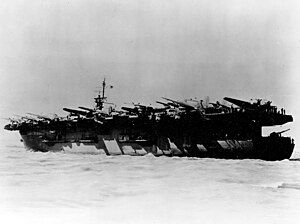USS Kadashan Bay (CVE-76)

USS Kadashan Bay (CVE-76) transporting aircraft
|
|
| History | |
|---|---|
| Name: | USS Kadashan Bay |
| Namesake: | Kadashan Bay |
| Builder: | Kaiser Shipyards |
| Launched: | 11 December 1943 |
| Commissioned: | 18 January 1944 |
| Decommissioned: | 14 June 1946 |
| Fate: | Scrapped 13 August 1959 |
| General characteristics | |
| Class and type: | Casablanca-class escort carrier |
| Displacement: | 7,800 tons |
| Length: | 512 ft 3 in (156.13 m) |
| Beam: |
|
| Draft: | 22 ft 6 in (6.86 m) |
| Speed: | 19 knots (35 km/h) |
| Complement: |
|
| Armament: |
|
| Aircraft carried: | 28 |
| Service record | |
| Part of: |
|
| Operations: | |
| Awards: | 2 Battle stars |
USS Kadashan Bay (CVE-76) was a Casablanca class escort carrier of the United States Navy. She is named for Kadashan Bay Alaska.
Kadashan Bay was launched 11 December 1943 by the Kaiser Shipbuilding Company in Vancouver, Washington, under a Maritime Commission contract; sponsored by Miss Audrey Ackerman and commissioned 18 January 1944, Captain R. N. Hunter in command.
After shakedown Kadashan Bay departed San Diego 6 March 1944 on the first of two cruises to Espiritu Santo. She transported a total of 154 aircraft on these assignments before returning San Diego 13 May. Following repairs and training, the escort carrier sailed 10 July to join a carrier division at Pearl Harbor. One month later she sailed for Tulagi and final preparations for the September assault on the Palaus.
Kadashan Bay departed Tulagi 6 September and six days later her air group launched a pre-invasion air attack against enemy positions on Peleliu. Ground forces landed 15 September to gain control of the island as an air base to support the Philippine operation. After preparations were concluded at Manus, the escort carrier steamed toward the Leyte Gulf 14 October.
Arriving there 21 October she immediately commenced raids and strikes in support of troops ashore. Four days later one of her patrol planes, piloted by Ensign Hans L. Jensen, sighted the Central Force of the Japanese fleet off Samar. After reporting his sighting he launched an unsupported attack against the leading cruiser, beginning the famous battle off Samar. The carrier's air group launched three fighter and three torpedo strikes against Kurita's force. The flyers' courage and gallantry contributed greatly to the sound defeat from which the Japanese never recovered. Upon completion of this mission, Kadashan Bay steamed toward Manus, arriving 3 November.
...
Wikipedia
